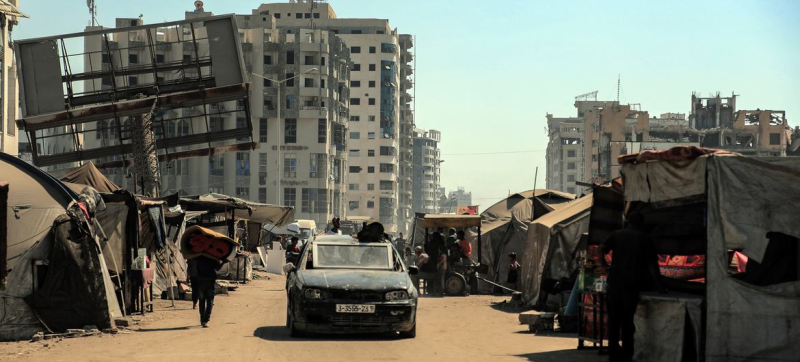- Record 676 Million Women Exposed to Deadly Conflicts |
- UN Renews Push for Global Elimination of Nuclear Arms |
- Don't leave healthcare to profit-driven actors: Prof Yunus |
- Key issues that Prof Yunus may raise in UNGA speech Friday |
- Israeli Strikes Intensify Gaza City Crisis, Casualties Rise |
Four Gaza Hospitals Close as Israeli Assault Intensifies

Tent shelters west of Gaza City.
The escalating Israeli military offensive in Gaza City continues to overwhelm medical professionals, with four more hospitals forced to shut down this month alone in the north of the war-torn enclave, the UN World Health Organization (WHO) said on Friday.
“This brings the total functioning hospitals in Gaza to only 14… The situation at the remaining eight hospitals and one field hospital in the city is critical,” said WHO spokesperson Tarik Jasarevic.
The closures come as Israeli forces continue to push into Gaza City with the declared aim of dislodging Hamas fighters believed to be based there. At the same time, repeated Israel Defense Forces evacuation orders have uprooted hundreds of thousands of people and affected hundreds of health facilities.
“Even if hospitals are not asked to evacuate, there is a lack of access, there is violence nearby, and that can put them out of service,” Mr Jasarevic told journalists in Geneva.
Gaza City forms the backbone of the Strip’s health system, with nearly half of all hospitals and field hospitals based there.
“Hospitals in the south are overwhelmed and can’t absorb more,” WHO warned in a statement, noting that the enclave’s remaining hospitals include eight in Gaza City, three in Deir al-Balah, and three in Khan Younis. None is functioning at full capacity, the UN health agency stressed.
The four north Gaza hospitals put out of service since 1 September are Al-Rantisi Children’s Hospital, the Ophthalmic Hospital, St John Eye Hospital, and Hamad Hospital for Rehabilitation and Prosthetics.
WHO describes Hamad Hospital as one of the three main specialized rehabilitation facilities in the Strip. It had been serving 250 outpatients with rehabilitation services and about 200 trauma patients daily.
Al-Rantisi Hospital sustained severe damage from a direct strike on 16 September while 80 patients were inside. It is the only specialized paediatric hospital left in Gaza. No fatalities were reported, but rooftop water tanks, communication systems, and medical equipment were badly damaged.
Half of the patients fled, while some 40 others remain inside, including four children in intensive care and eight newborns, according to WHO. Most of its equipment was transferred to Al-Helou, As-Sahaba, and Patient Friendly hospitals in Gaza City.
In addition to the latest closures, the situation is “critical” at Gaza City’s remaining hospitals and field hospital. They are “overwhelmed by the influx of casualties,” low on supplies, and forced to treat patients on the floor.
WHO highlighted severe shortages in blood units, bags, and transfusion sets, warning that “services could shut down within days, without urgent replenishment.”
According to the UN health agency, all but one of the dozen reported attacks on healthcare between 7 and 17 September occurred in Gaza City, with Khan Younis accounting for the other.
“More violence only means more injured people, more casualties, more deaths, and less access,” Mr Jasarevic said. “People in Gaza are suffering from multiple displacements, shortages of medical supplies, and restricted access for humanitarians, health workers, and patients.”
He reiterated WHO’s call for the urgent evacuation of thousands of seriously ill patients in need of specialized care.
“Over 15,000 people need to be evacuated for medical reasons, and evacuations are proceeding very slowly,” he said. “Again, we can only appeal for a ceasefire and for unhindered access so we can try to support what is left of the health system in Gaza with medical supplies, emergency teams, and everything else.”

